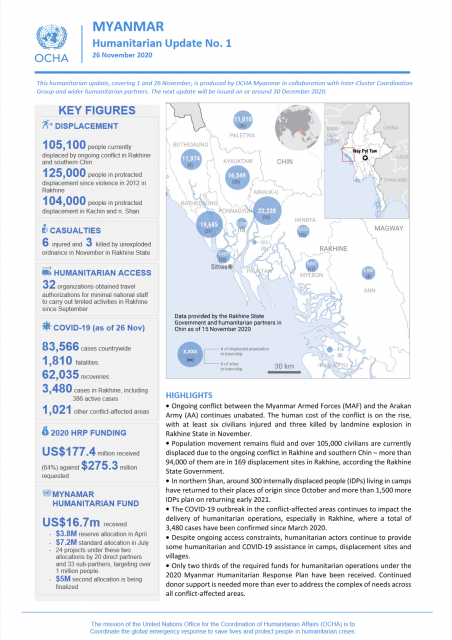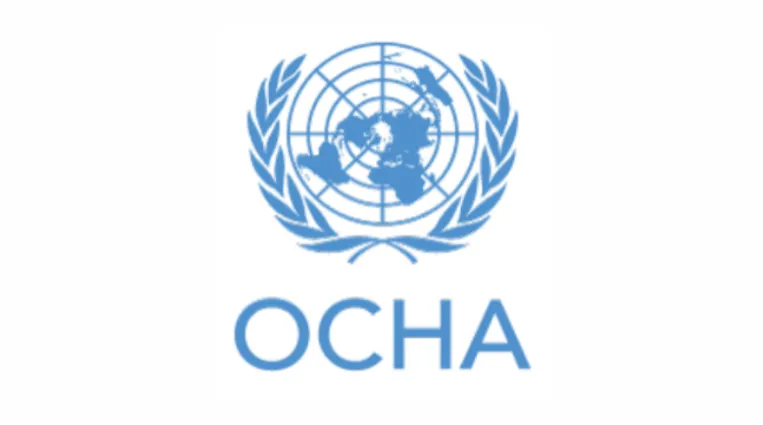
This humanitarian update, covering 1 and 26 November, is produced by OCHA Myanmar in collaboration with Inter-Cluster Coordination Group and wider humanitarian partners. The next update will be issued on or around 30 December 2020.
HIGHLIGHTS
• Ongoing conflict between the Myanmar Armed Forces (MAF) and the Arakan Army (AA) continues unabated. The human cost of the conflict is on the rise, with at least six civilians injured and three killed by landmine explosion in Rakhine State in November.
• Population movement remains fluid and over 105,000 civilians are currently displaced due to the ongoing conflict in Rakhine and southern Chin – more than 94,000 of them are in 169 displacement sites in Rakhine, according the Rakhine State Government.
• In northern Shan, around 300 internally displaced people (IDPs) living in camps have returned to their places of origin since October and more than 1,500 more IDPs plan on returning early 2021.
• The COVID-19 outbreak in the conflict-affected areas continues to impact the delivery of humanitarian operations, especially in Rakhine, where a total of 3,480 cases have been confirmed since March 2020.
• Despite ongoing access constraints, humanitarian actors continue to provide some humanitarian and COVID-19 assistance in camps, displacement sites and villages.
• Only two thirds of the required funds for humanitarian operations under the 2020 Myanmar Humanitarian Response Plan have been received. Continued donor support is needed more than ever to address the complex of needs across all conflict-affected areas.
SITUATION OVERVIEW
INTERNAL DISPLACEMENT IN RAKHINE AND SOUTHERN CHIN ON A STEADY RISE: The conflict between the MAF and AA in Rakhine and southern areas of Chin states, which erupted in January 2019, has continued during the reporting period, with reports of civilian casualties and severe humanitarian impact. Small scale displacements have been reported across several townships in Rakhine State in recent weeks. This includes the displacement of some 2,100 people in 13 villages in Kyaukpyu Township between 2 and 8 November, due to reported presence of MAF soldiers in the area. Similar incidents of population movement were reported in Minbya and Mrauk-U townships between 2 and 22 November, where around 780 people from seven villages reportedly fled from their homes to nearby villages as soldiers increased their presence in the area. Continued hostilities in Ann Township have also reportedly forced some 400 people from two villages to flee to safer areas in Kan Htaunt Gyi town and a displacement site on 11 November. Over a thousand households have also returned to their places of origin in Ann, Kyaukpyu and Ramree townships in November after improvement of the security situation in certain areas. The displacement numbers have been obtained by local sources and cannot be verified due to access challenges.
The overall number of people displaced due to the ongoing conflict has seen a steady rise since January 2020. As of 15 November, 105,090 people were hosted across 205 sites and host communities in Rakhine and southern Chin states. In Rakhine, 87,467 people are currently hosted in 169 sites, while around 6,613 displaced persons are sheltering in some 30 host communities, according to the Rakhine State Government (RSG). In Paletwa Township, which has been the main area of hostilities in southern Chin State, humanitarian partners report that some 11,010 displaced persons remained in 36 sites as of October. The current displacement figures are more than the double the numbers reported in January 2020, when over 49,700 IDPs were hosted in 137 sites in the two states.
CLASHES TEMPORARILY DISPLACE THOUSANDS IN NORTHERN SHAN: In northern Shan, an overall reduction in the frequency and intensity of the conflict has been observed in 2020, even though small-scale clashes were reported among the MAF and ethnic armed organizations. Between 30 September and mid-October 2020, a series of fighting between the MAF and the Restoration Council of Shan State/Shan State Army were reported in Kyaukme Township. Clashes were initially reported along the Lashio-Mandalay highway but quickly extended to the bend of the Namtu River near the Upper Ye Ywa hydro-power construction site. According to local sources, the intensity of the clashes and security operations in the area have resulted in the temporary displacement of more than 4,500 persons (1,300 households) from at least 17 villages in southern areas of Kyaukme Township between 3 and 20 October. Displacements were of a relatively short period, lasting between 6 and 14 days depending on the site. As of 21 October, all IDPs had reportedly returned to their villages of origin. This was the second series of clashes in the area in 2020. About 1,000 people from 10 villages were temporarily displaced in June due to similar clashes in Kyaukme Township.
INCREASING HUMAN COST OF THE CONFLICT IN RAKHINE: Increased reports of civilian casualties due to the conflict in Rakhine remain a major protection of civilians concern. An unexploded ordnance explosion in Maungdaw Township on 17 November killed a child and his parents, and injured six civilians, including four children. Between January and September 2020, at least 13 children have been killed and 56 severely injured due to landmines and unexploded ordnances, with Rakhine State seeing the highest rate of casualties among children, according to UNICEF. On 11 November, public sources have also reported that six civilians, including four children, were injured due to an artillery shelling in Ann Township in Rakhine State. The details of this incident could not be verified due to access and security challenges. Similar high-profile incidents were reported in October. The Country Task Force on Monitoring and Reporting (CTFMR) stated concerns over circumstances of two children killed in crossfire in Buthidaung Township on 5 October. On 22 October, UNICEF published a statement expressing sorrow over the death of a boy, who was reportedly killed due to artillery shelling in Mrauk-U Township. This followed an incident on 10 September, where two children were killed and one more injured in Myebon Township following an artillery fire.
RETURN AND RESETTLEMENT IN NORTHERN SHAN: Close to 300 IDPs in two camps in Kutkai Township in northern Shan have returned to their places of origin since October. An additional 1,500 IDPs in seven camps in Namkhan, Kutkai and Manton townships, who were displaced between 2013 and 2016, plan to return to their places of origin early 2021, according to the camp management agencies and civil society organizations on the ground. These returns are being facilitated by the camp management agencies and local faith-based organizations. The United Nations is closely coordinating with partners and local governments to support the return and resettlement processes in line with international standards.
Earlier on 2 November, local sources reported that some 84 people in the Man Loi camp in Kutkai Township displaced in 2016 have also returned to their places of origin due to improved access to livelihoods and a stable security situation. As of 31 August, northern Shan hosted around 10,000 IDPs, who were displaced since the escalation of conflict in 2013.

